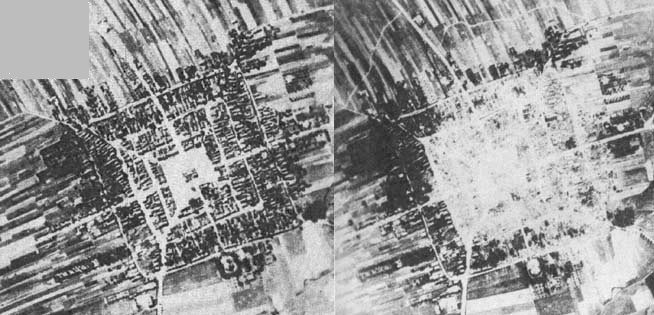On 13 September 1939, German aircraft bombed the small town of Frampol. As a result of the raid, 80% of its buildings ceased to exist. The German Luftwaffe treated the town as a testing ground because of its unique architectural layout.
Frampol, a town located in the Lublin region, was founded in the early 18th century. It was intended to have an ideal layout of buildings. In its heart, there was a huge square market measuring 225 m x 225 m – the largest in Europe (the market square in Kraków is 200 m x 200 m). It was surrounded by quarters with buildings, which were connected by eight streets radiating out from the centre of the market. The vast majority of the town’s buildings were wooden. Before the outbreak of the Second World War alone, it had a population of around 3,000. Of these, more than half were Jews.
These ideal buildings, a source of pride for Frampol’s residents, became the cause of the town’s destruction after Germany invaded Poland on 1 September 1939. The Third Reich entrusted a major role in the war effort to the air force – the Luftwaffe. Its task was not only to attack military targets, but also, or above all, to bomb civilian buildings, not excluding hospitals and churches. German airmen also fired on columns of civilian refugees with their airborne weapons.
In September 1939. Frampol became the target of a bombing raid. A few days before it, the town had been photographed from the air by one of the reconnaissance planes. There was no military infrastructure in the town itself, and it became a target because of its ideal buildings. German aircraft used the layout of the town as a testing ground, presumably to test the effectiveness of incendiary bombs.
On the afternoon of 13 September 1939, 6 Heinkel He – 111 aircraft from the 1st Squadron (Staffel) belonging to the 55th Regiment (Kampfgeschwader) flew over Frampol and dropped their deadly load. The bombs led to a huge fire that consumed 80 % of the town’s buildings. Around 10 people died as a result of the raid. The losses would certainly have been larger had it not been for the alarm raised by the local anti-aircraft outpost. A few days after the attack, Frampol was again photographed by a German reconnaissance plane.
Because of the extent of the town’s destruction, it has been compared to the Spanish Guernica bombed by pilots of the German Condor Legion on 26 April 1937.





